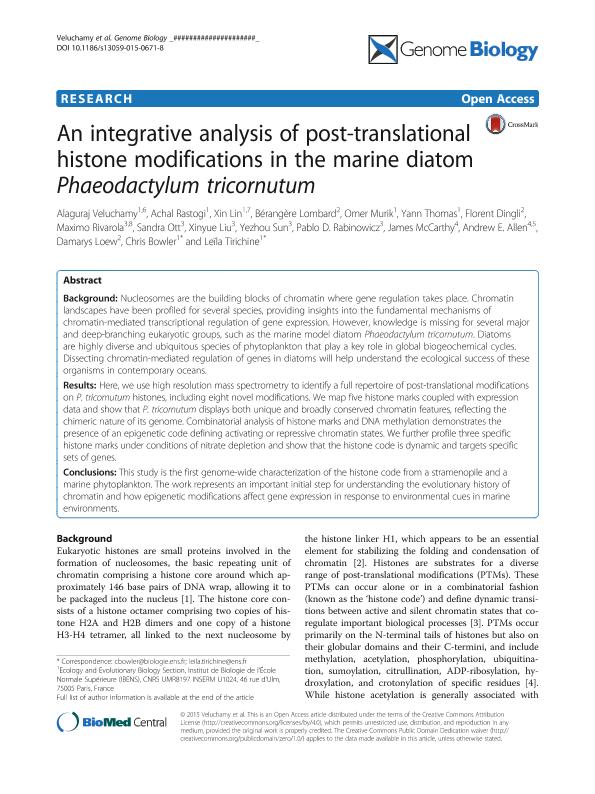Mostrar el registro sencillo del ítem
dc.contributor.author
Veluchamy, Alaguraj
dc.contributor.author
Rastogi, Achal
dc.contributor.author
Lin, Xin
dc.contributor.author
Lombard, Bérangère
dc.contributor.author
Murik, Omer
dc.contributor.author
Yann, Thomas
dc.contributor.author
Dingli, Florent
dc.contributor.author
Rivarola, Maximo Lisandro

dc.contributor.author
Ott, Sandra
dc.contributor.author
Liu, Xinyue
dc.contributor.author
Sun, Yezhou
dc.contributor.author
Rabinowicz, Pablo D.
dc.contributor.author
McCarthy, James
dc.contributor.author
Allen, Andrew E.
dc.contributor.author
Loew, Damarys
dc.contributor.author
Bowler, Chris
dc.contributor.author
Tirichine, Leila
dc.date.available
2020-08-14T13:44:09Z
dc.date.issued
2015-05
dc.identifier.citation
Veluchamy, Alaguraj; Rastogi, Achal; Lin, Xin; Lombard, Bérangère; Murik, Omer; et al.; An integrative analysis of post-translational histone modifications in the marine diatom Phaeodactylum tricornutum; BioMed Central; Genome Biology; 16; 1; 5-2015; 1-18
dc.identifier.issn
1474-760X
dc.identifier.uri
http://hdl.handle.net/11336/111731
dc.description.abstract
Background: Nucleosomes are the building blocks of chromatin where gene regulation takes place. Chromatin landscapes have been profiled for several species, providing insights into the fundamental mechanisms of chromatin-mediated transcriptional regulation of gene expression. However, knowledge is missing for several major and deep-branching eukaryotic groups, such as the marine model diatom Phaeodactylum tricornutum. Diatoms are highly diverse and ubiquitous species of phytoplankton that play a key role in global biogeochemical cycles. Dissecting chromatin-mediated regulation of genes in diatoms will help understand the ecological success of these organisms in contemporary oceans.Results: Here, we use high resolution mass spectrometry to identify a full repertoire of post-translational modifications on P. tricornutum histones, including eight novel modifications. We map five histone marks coupled with expression data and show that P. tricornutum displays both unique and broadly conserved chromatin features, reflecting the chimeric nature of its genome. Combinatorial analysis of histone marks and DNA methylation demonstrates the presence of an epigenetic code defining activating or repressive chromatin states. We further profile three specific histone marks under conditions of nitrate depletion and show that the histone code is dynamic and targets specific sets of genes.Conclusions: This study is the first genome-wide characterization of the histone code from a stramenopile and a marine phytoplankton. The work represents an important initial step for understanding the evolutionary history of chromatin and how epigenetic modifications affect gene expression in response to environmental cues in marine environments.
dc.format
application/pdf
dc.language.iso
eng
dc.publisher
BioMed Central

dc.rights
info:eu-repo/semantics/openAccess
dc.rights.uri
https://creativecommons.org/licenses/by-nc-sa/2.5/ar/
dc.subject
EPIGENOMICA
dc.subject
GENOMICA
dc.subject
TRANSCRIPTOMICA
dc.subject.classification
Ciencias de la Información y Bioinformática

dc.subject.classification
Ciencias de la Computación e Información

dc.subject.classification
CIENCIAS NATURALES Y EXACTAS

dc.title
An integrative analysis of post-translational histone modifications in the marine diatom Phaeodactylum tricornutum
dc.type
info:eu-repo/semantics/article
dc.type
info:ar-repo/semantics/artículo
dc.type
info:eu-repo/semantics/publishedVersion
dc.date.updated
2020-08-11T15:29:38Z
dc.journal.volume
16
dc.journal.number
1
dc.journal.pagination
1-18
dc.journal.pais
Reino Unido

dc.journal.ciudad
Londres
dc.description.fil
Fil: Veluchamy, Alaguraj. King Abdullah University of Science and Technology; Arabia Saudita. Centre National de la Recherche Scientifique; Francia
dc.description.fil
Fil: Rastogi, Achal. Centre National de la Recherche Scientifique; Francia
dc.description.fil
Fil: Lin, Xin. Centre National de la Recherche Scientifique; Francia. Xiamen University; China
dc.description.fil
Fil: Lombard, Bérangère. PSL Research University
; Francia
dc.description.fil
Fil: Murik, Omer. Centre National de la Recherche Scientifique; Francia
dc.description.fil
Fil: Yann, Thomas. Centre National de la Recherche Scientifique; Francia
dc.description.fil
Fil: Dingli, Florent. PSL Research University
; Francia
dc.description.fil
Fil: Rivarola, Maximo Lisandro. Instituto Nacional de Tecnología Agropecuaria. Centro de Investigación en Ciencias Veterinarias y Agronómicas. Instituto de Biotecnología; Argentina. Consejo Nacional de Investigaciones Científicas y Técnicas; Argentina. University of Maryland; Estados Unidos
dc.description.fil
Fil: Ott, Sandra. University of Maryland; Estados Unidos
dc.description.fil
Fil: Liu, Xinyue. University of Maryland; Estados Unidos
dc.description.fil
Fil: Sun, Yezhou. University of Maryland; Estados Unidos
dc.description.fil
Fil: Rabinowicz, Pablo D.. University of Maryland; Estados Unidos
dc.description.fil
Fil: McCarthy, James. Instituto J. Craig Venter; Estados Unidos
dc.description.fil
Fil: Allen, Andrew E.. Instituto J. Craig Venter; Estados Unidos. University of California; Estados Unidos
dc.description.fil
Fil: Loew, Damarys. PSL Research University; Francia
dc.description.fil
Fil: Bowler, Chris. Centre National de la Recherche Scientifique; Francia
dc.description.fil
Fil: Tirichine, Leila. Centre National de la Recherche Scientifique; Francia
dc.journal.title
Genome Biology

dc.relation.alternativeid
info:eu-repo/semantics/altIdentifier/url/https://genomebiology.biomedcentral.com/articles/10.1186/s13059-015-0671-8
dc.relation.alternativeid
info:eu-repo/semantics/altIdentifier/doi/http://dx.doi.org/10.1186/s13059-015-0671-8
Archivos asociados
